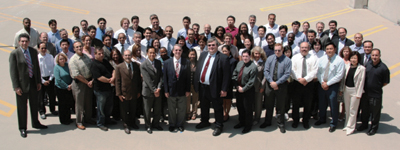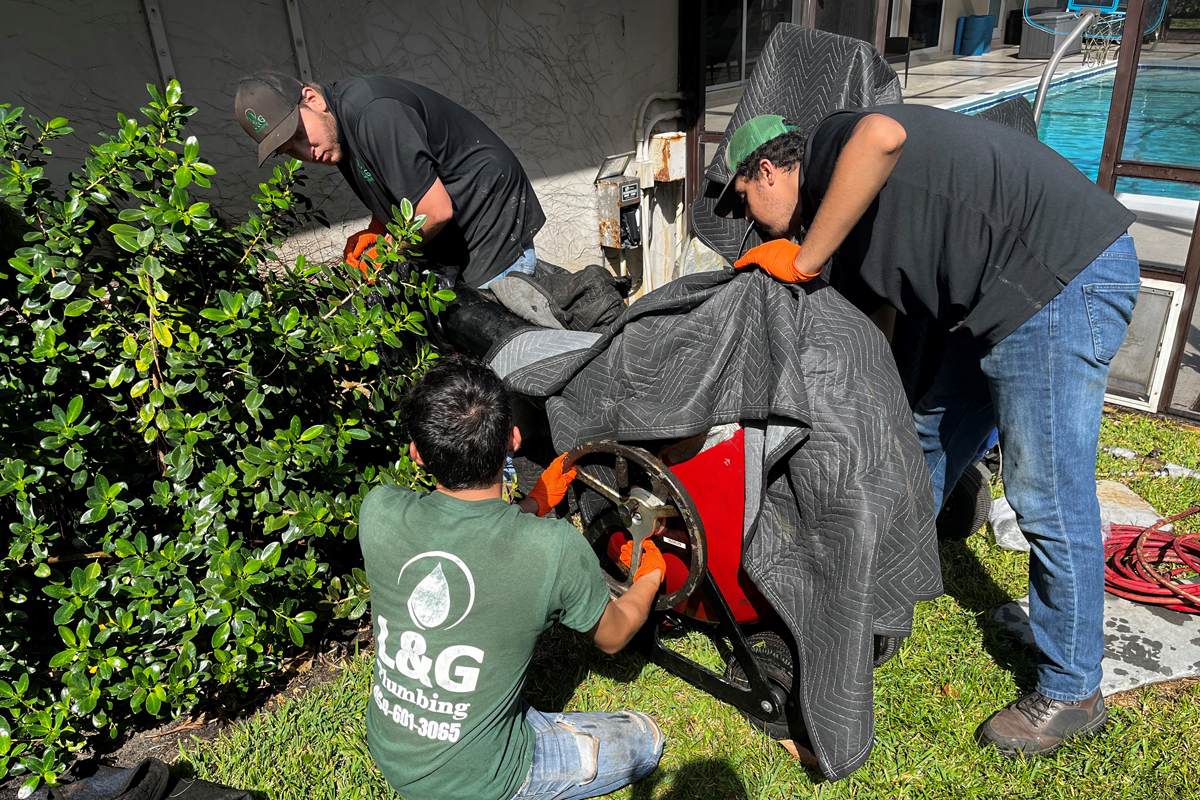2010 Trenchless Technology Person of the Year: Keith Hanks

Keith is a life-long municipal employee for the City of Los Angeles who has worked tirelessly in the pursuit of finding the most cost-effective and efficient methods to rehabilitate and replace the city’s underground infrastructure. He has developed guidelines for his city’s approved methods and materials and has been a strong advocate for the trenchless industry. He has served on industry boards and has presented papers in the advocacy of the trenchless market.
His goal is to open the dialogue amongst municipalities and owners and the trenchless industry, which will ultimately make the trenchless market stronger. Keith has been involved in the design and construction of wastewater projects, including treatment plants, major sewer design and construction and sewer rehabilitation. Because of his passion for and belief in trenchless methods, Keith has evaluated most trenchless methods, some new and innovative, for use in more than 60 miles of large dimension sewers.
Background
Keith earned his bachelor of science and master of civil engineering degrees from Brigham Young University (BYU) in 1985, under the school’s integrated masters program. In 1992, he earned his master of business administration.
Engineering is a part of the Hanks family foundation. His father Richard was a professor of chemical engineering at BYU and three of his sons have pursued engineering careers, with two following their dad into chemical engineering. Keith chose civil engineering as his path. Not one to back away from a challenge, the Hanks’ brothers even took their dad’s advanced fluid mechanics class, which Keith described as the most difficult class he’s ever taken.
“My Dad’s tests were always take-home, open-book tests where you could take all the time you needed but you just couldn’t talk with the other kids in the class. I remember one particular test where I vividly imagined taking the book out in the middle of the street and throwing it as far as I could. It was that hard!” Keith remembered.
When Keith first started college, his intent was to become a drafting technician. Drafting was a field he fell in love with in high school and really enjoyed its drawing aspect. His father even secured him a job with a consulting company in its drafting office, giving him early experience in civil engineering drafting. However, returning to his job and school after taking a two-year break to fulfill being a Mormon missionary in Italy, he came to a decision: He wanted to focus on being a civil engineer.
“I had decided when I was working for the consulting company that as much as I liked drafting, I saw the young engineers giving the old drafting guys instructions and I thought, ‘I really want a job where I get to think.’ That’s when I decided to go into civil engineering,” Keith said.
By the time Keith graduated in 1985, he was married and had four children. He said it took him a little longer to graduate than most because he took time off to support his growing family. He worked as a construction inspector at the Salt Lake City International Airport during the summers to earn money. Working as a construction inspector was an experience that Keith said he has carried with him during his professional life — that real world experience you can’t find in a book or classroom and something he believes a lot of young engineers are lacking today.
“That construction experience has been very good for me,” he said. “It gave me an awful lot of firsthand construction experience that I see a lot of our young kids don’t have. They’ve been through school and they’ve received a good education but they haven’t been hands-on in the field. I’ve been there as a construction inspector, working with contractors and the other inspectors and engineers. It’s been a resource that I’ve drawn on quite a bit through my career.”
While still at BYU, Keith interviewed with the Los Angeles Department of Water and Power to get on its civil service hiring list. The job invitation came from the Department of Public Works Bureau of Engineering, Wastewater Systems Engineering Division. “All I knew about the job was that it was in Los Angeles and it was a job,” Keith said, laughing. He accepted the position and the lifelong Utah resident packed up his family and headed to California.
He started with Los Angeles in August 1985 in the Wastewater Treatment Plant design group and his first few years were spent doing design projects and expanding the Tillman Water Reclamation Plant. He was promoted into a capital improvement group in the Bureau of Sanitation Wastewater Treatment Division, which supported the three smaller treatment plants operated by Los Angeles.
Keith was brought back to the Bureau of Engineering in 1994 to work on the design of the East Central Interceptor Sewer (ECIS), which ended up as an 11-mile, 16-ft diameter tunnel with an 11-ft finished interior diameter. “ECIS was a long project. A project that becomes your life after awhile and you begin to wonder if there is going to be life after ECIS!” he said.
Keith was promoted again, to senior engineer in 1999 and supervised a design and construction management group dealing with sewer construction and rehabilitation using both trenchless and conventional methods — a position he holds today, overseeing at times more than 50 employees.
“We had a lot of the work focused on how we were going to rehabilitate the North Outfall Sewer, which has been the city’s backbone system since the 1920s,” Keith said. “It was built in three different configurations. For $12.5 million, we built the North Outfall Sewer and the first generation Hyperion Treatment Plant. If we could build them for that cost now!”
His work on this project brought with it the use of trenchless technology, specifically sliplining. “We had gotten good at sliplining the circular sections and most of that work was done with HOBAS pipe and one with Spirolite,” Keith said. “We did not have an alternative for rehabilitation of the non-circular pipe in our system. We also did not have the ability to dry our sewer out, which required that we develop a way of rehabilitating our sewers live.”

Keith said he got a hold of an old Metcalf & Eddy manual that had several pages of non-circular sewer configurations from around the United States. He copied that chapter, added the L.A. sewers to the list and then gave it to anyone who would take it. “Let them draw the conclusion that there are a lot of pipes out there that are non-circular that need to be fixed,” he said. “The conclusion I was hoping people in the industry would draw was: We can get a start in L.A. and we can develop these products and once we show them they work, then rehabilitation opportunities will come and justify the initial expense. What we had was the seed program with money to get it started. And [the industry] has done it and developed products we can use.”
Trenchless in L.A.
The City of Los Angeles and Keith got their feet wet with trenchless technologies with microtunneling and some tunneling. But the city got into the trenchless market in a big way after the Northridge Earthquake in 1994. “We had so much damage to our clay pipes in the sewers that we had to repair them. That’s really when I think CIPP took off with us,” Keith said, noting that he was not particularly involved with that undertaking but easily understood the rationale for turning to trenchless to fix the damage. Over the years, the city has used CIPP, fold-and-form and some pipe bursting and HDD.
“We have to have [trenchless technologies],” Keith said. “When you are working in a congested, urban environment, you need to be able to reduce the impact and trenchless allows us to do that. Also, we have found that by opening it up to competition, both trenchless and open-cut, the price came down dramatically for both, saving the city a ton of money.”
Through his work with trenchless technologies, Keith was introduced to the North American Society for Trenchless Technology (NASTT) in 2001 and quickly became the city’s representative to the organization, as well as providing municipal perspective to NASTT. Over the years, Keith has served on NASTT’s board of directors, as well as its secretary and its treasurer. He also is involved with the Water Environment Federation (WEF) and participates on the Trenchless Technology Center’s (TTC) industry advisory board.
Keith is also a city councilman for the City of Azusa, serving the last five years. While sitting on the budgetary side of things gives him perspective in his job, Keith said it’s his public works background that is an asset to his role as city councilman. “They [city staff and city manager] recognize that I have experience in public works and that gives me credibility when we talk about infrastructure, particularly about sewers,” he said.
As an example, Keith noted that he brought in David O’Sullivan, president of PW Trenchless Construction, to give a presentation to the Southern California Association of Governments’ Energy and Environment Committee, which Keith chairs, on the carbon calculator, developed by NASTT’s Northwest Chapter, and the benefits of trenchless technology — a presentation that generated interest by mayors and council members and proved his point in his own mind that this is what the trenchless industry needs to do.

Keith is also an advocate of more communication between owners and municipalities, saying that, “We don’t talk to each other nearly as much as we should.” He likes the municipal forums that are organized by TTC but he said there needs to be more sharing of ideas and discussion of what works in the various municipalities. “I think a lot of times, we all invent the wheel when we don’t have to,” Keith said.
Person of the Year
Looking back, Keith said it’s hard to believe he has spent his entire professional career working with underground infrastructure when he believed he was going to be working in the coal slurry industry, following his father, who specialized in the flow properties of slurries. “My Dad did some consulting on the side and I did some testing of flow properties of slurries. We even built our own viscometer that was worthy of a civil engineer,” Keith said. But then he got the job offer with Los Angeles.
“It was a very good choice and it’s been a great job,” Keith said. “I had no idea about wastewater when I started and everything I learned has been through osmosis. But it’s been fun.”
It’s also been a career in which he has been able to share with his wife of more than 30 years, Belinda, who accompanies Keith on his industry travels.
Keith was humbled and taken aback by his selection of Person of the Year. “I was very surprised by the news,” Keith said of his initial reaction. “I’ve known several of the people who have been named Person the Year in past years and it’s amazing to be put in this group. David Bennett said it best a couple of years ago when he was selected, saying, ‘This is really cool.’ And it really is. It’s nice to have this recognition and it’s humbling. I didn’t do this all by myself — there’s a whole bunch of people in my office who are a part of this.
“It’s really nice to be selected for this honor and it’s nice for the City of Los Angeles to have me chosen. It’s a nice compliment to the city.”
Sharon M. Bueno is managing editor of Trenchless Technology.




